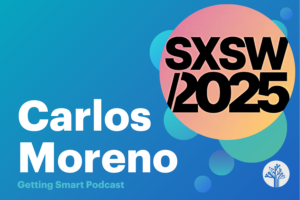ASU+GSV Summit: Learning at the Speed of Light

GSV Takes On Society’s Greatest Challenge: Their mission is to create a world in which ALL people have equal access to the future and we believe that scaled innovations in the delivery of education and workforce skills are critical to achieving that end. With four days of community, connection, and critical conversations, you’ll want to maximize every second of your time in San Diego! See the schedule below to help you plan your travel and your Summit experience.
Catch Us At The Event!
We’re thrilled to be attending and participating in a few of the amazing sessions! Be sure to find one of the following Getting Smart team members to say hi:
New Credentialing Strategies That Make Experience Count
In the way traditional transcripts have been used to document what you know, digital credentials are a growing way to signal capabilities. As of 2024, employees and learners can earn nearly a million viable credentials to demonstrate competency. In fact, Credly has awarded over 81 million credentials to date, and a Lumina sponsored report found that 28 states have invested at least $3.8 billion in short-term credential pathways. Most of these credentials are awarded for demonstrations of technical skills but there is growing interest in credentialing skills learned through hands-on learning experiences. Join this discussion to learn more about these approaches and about a recent report, Expanding Access, Value and Experiences Through Credentialing, that outlines strategies to make valuable experiences like internship count to reduce reliance on traditional signals including transcripts and resumes. Learn More.
Accelerating to the Unknown: STEM Pathways for the Future
In a world where technology evolves at light speed, schools and networks are tasked with preparing students for a future filled with new opportunities and emerging fields. This interactive session dives into the transformative impact of cutting-edge technologies on the future of work, with a focus on building inclusive, innovative STEM pathways that connect learners to real-world opportunities — including updated strategies for STEM curriculum design, practical approaches for integrating AI, and insights into fostering STEM pathways that are both accessible and adaptable. Discover how to inspire the next generation of innovators and equip learners with the skills they need to thrive in a tech-driven world. Learn More.
Crashing through Roadblocks: Debunking High School Work-based Learning Barriers
When the topic of internships comes up, many businesses automatically put up roadblocks to employing young interns and apprentices: “We don’t have work suited for workers younger than 18.” “Students don’t have a way to get to our offices.” “It’s against the law and/or such-and-such policy to have youth in our workspace because of safety issues, or because we are a financial institution, a hospital, etc.” “Year-round internships for high school students aren’t possible because of their schedules.” But too often, these employers are failing to recognize the real value youth can bring to the workplace. This session will open with an overview of employers’ most commonly reported logistical barriers to youth work-based learning (finding suitable work, transportation, liability/safety concerns, scheduling followed by a discussion on policy barriers, engaging school systems and employers partners, and measuring & communicating learner impact. Then, participants will have a chance to join a breakout discussion and brainstorm solutions (or offer real-life examples of how they implemented solutions) to a particular barrier. Participants will come away with ideas to build buy-in to persuade naysayers in the workplace and create a welcoming work environment for youth younger than 18. Learn More.
The Portrait of a Teacher in the Age of AI
Districts all over the US have been creating competency-based “Portraits of a Graduate” to identify markers for student success. But in order for students to be happy, agentic, critical thinkers, teachers need to be happy, agentic, critical thinkers. If AI can replace tutoring, personalization, curation, and so much more for learners, what role should teachers have? What should teachers continue doing and what should they lean on AI for? What should the Portrait of a Teacher be? This session will illuminate the competencies teachers need in the Age of AI and identify how to update our expectations for educators, reimagine the teaching role, and hire more thoughtfully. Learn More.


